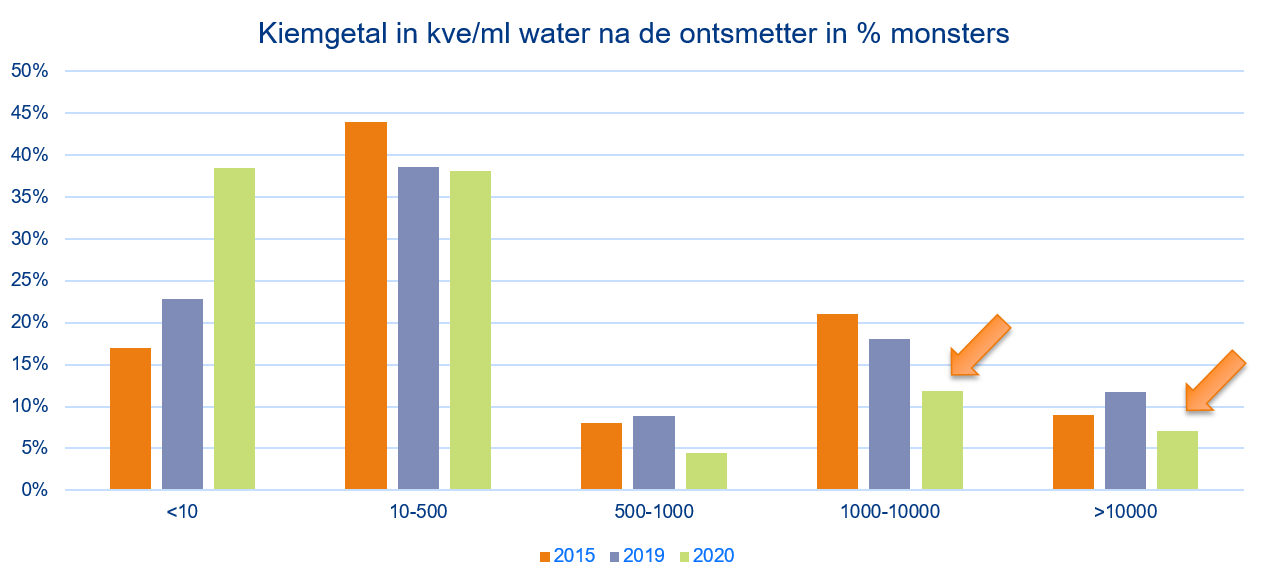Keep an eye on disinfector efficacy
1 June 2021 - Articles
Greenhouse disinfection systems are becoming ever more effective. This is revealed by the water samples taken with the DisinfectorCheck over the past five years. However, one in five samples still exceeds the target value of <500 CFU/ml (colony forming units).
Since the water treatment requirement came into force in the Netherlands, many companies have installed a disinfection system. After all, only water that is clean and contains no pathogens can be recirculated. The effectiveness of the disinfector is therefore of crucial importance. “It is really important to maintain your system regularly and to check that it is killing off bacteria, fungi and viruses effectively," says Jan Hardeman, account manager at Eurofins Agro.

Figure 1: Plate count in CFU/ml water after disinfector in % samples. Source: Eurofins Agro 2021
Above the threshold
Eurofins Agro has summarised the results of five years of research (figure 1). This shows that in 2020, one in five samples was still exceeding the Eurofins Agro target value of <500 CFU/ml. These colonies can contain harmful organisms. "This is not what you want, of course,” Hardeman says. According to him, there are various possible causes for this less-than-optimal pathogen elimination:
- Too low transmission value of the water in the UV disinfector
- Poor disinfector maintenance (e.g. old UV lamps)
- Incorrect settings or disinfectant dosages
It is also important to remember that water samples must be taken accurately and in a sterile way. Sampling protocols have therefore been drawn up. "It can also be useful to analyse the water in multiple places at the company. Fungi and bacteria can even occur and multiply in fertiliser tanks," he says. "There are examples of water samples from a fertiliser tank in which Phytophthora spp. and Pythium spp. were found."
Virus too
Besides fungi and bacteria, the water can also contain harmful viruses. “Viruses are often found in low concentrations in water. That makes them difficult to measure," Hardeman says. Viruses that are easy to measure before disinfection are Tobacco Mosaic Virus (TMV), Tomato Mosaic Virus (ToMV) and Cucumber Green Mottle Mosaic Virus (CGMMV). To do this we use a biotest followed by an ELISA test. Tomato Brown Rugose Fruit Virus (ToBRFV) can be measured using a direct PCR test in water. With a PCR test, it is important to remember that a negative result is no guarantee that the virus is not present. The concentration of the virus in the water could be too low to be measured. On the other hand, if the result is positive, you know for sure that the virus is present. But even then, the vitality of the virus may still be questionable.”
Different analysis methods
To ensure the disinfector is working properly and to check for the presence of pathogens, a water sample is taken before and after the isinfector. The samples for the DisinfectorCheck are sent to the Eurofins Agro microbiology lab, chilled and in sterile bottles. In the lab we check for the presence of bacteria and fungi by determining the aerobic plate count (the number of bacteria, fungi and other microorganisms growing on a culture) and the total number of fungi. The effectiveness of the disinfector is then checked by comparing the results of the two samples side-by-side. The analysis takes between five and seven working days from receipt of the water sample in the laboratory.
This test is suitable for all types of disinfection systems (heating, UV, oxidation with ozone or hydrogen peroxide etc.). The DisinfectorCheck indicates the total bacterial count via a plating method. However, this test does not provide any information on which pathogens are present in the water. DNA techniques via DNA MultiScan can provide this information.
More information
Please contact horti@eurofins.com
